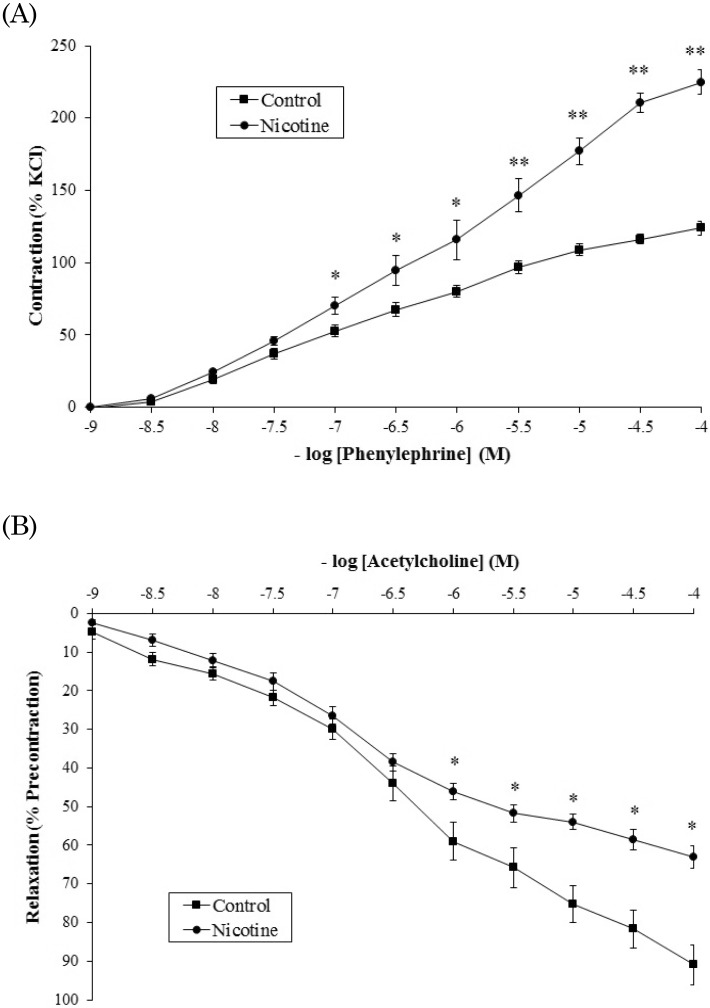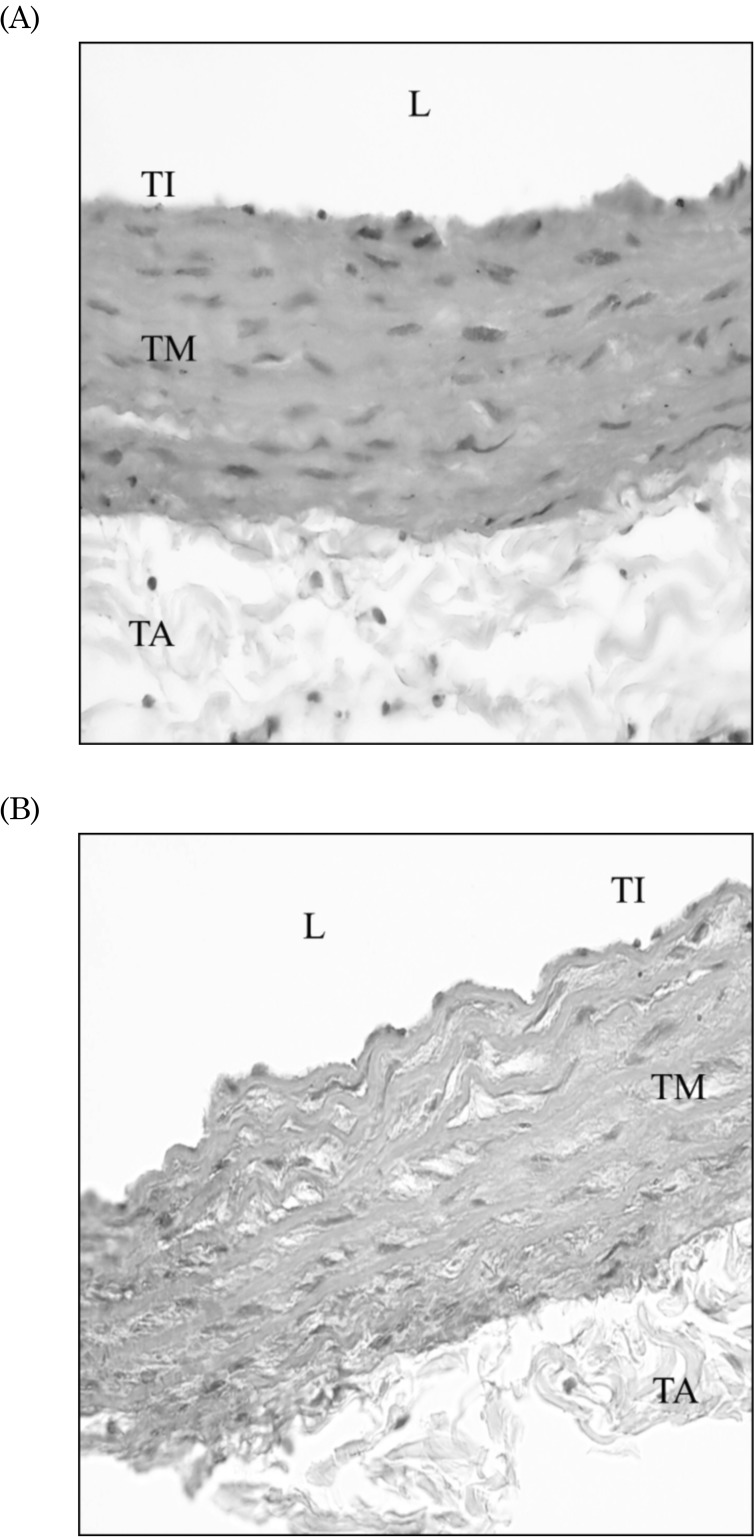1. Yildiz D, Ercal N, Armstrong DW. Nicotine enantiomers and oxidative stress. Toxicology. 1998; 130:155–165. PMID:
9865482.

2. Kovacic P, Cooksy A. Iminium metabolite mechanism for nicotine toxicity and addiction: Oxidative stress and electron transfer. Med Hypotheses. 2005; 64:104–111. PMID:
15533623.

3. Sener G, Kapucu C, Paskaloglu K, Ayanoglu-Dülger G, Arbak S, Ersoy Y, Alican I. Melatonin reverses urinary system and aorta damage in the rat due to chronic nicotine administration. J Pharm Pharmacol. 2004; 56:359–366. PMID:
15025861.

4. Halliwell B, Whiteman M. Measuring reactive species and oxidative damage
in vivo and in cell culture: how should you do it and what do the results mean? Br J Pharmacol. 2004; 142:231–255. PMID:
15155533.
5. Sener G, Sehirli AO, Ipçi Y, Cetinel S, Cikler E, Gedik N. Chronic nicotine toxicity is prevented by aqueous garlic extract. Plant Foods Hum Nutr. 2005; 60:77–86. PMID:
16021835.

6. Toklu HZ, Şehirli Ö, Şahin H, Çetinel Ş, Yeğen BC, Şener G. Resveratrol supplementation protects against chronic nicotineinduced oxidative damage and organ dysfunction in the rat urogenital system. Marmara Pharm J. 2010; 14:29–40.

7. Price RJ, Less JR, Van Gieson EJ, Skalak TC. Hemodynamic stresses and structural remodeling of anastomosing arteriolar networks: design principles of collateral arterioles. Microcirculation. 2002; 9:111–124. PMID:
11932778.

8. Pries AR, Reglin B, Secomb TW. Remodeling of blood vessels: responses of diameter and wall thickness to hemodynamic and metabolic stimuli. Hypertension. 2005; 46:725–731. PMID:
16172421.
9. Benowitz NL, Gourlay SG. Cardiovascular toxicity of nicotine: implications for nicotine replacement therapy. J Am Coll Cardiol. 1997; 29:1422–1431. PMID:
9180099.
10. Benowitz NL. Safety of nicotine in smokers with hypertension. Am J Hypertens. 2001; 14:731–732. PMID:
11465662.

11. de Diego AM, Tapia L, Alvarez RM, Mosquera M, Cortés L, López I, Gutiérrez LM, Gandía L, García AG. A low nicotine concentration augments vesicle motion and exocytosis triggered by K
+ depolarisation of chromaffin cells. Eur J Pharmacol. 2008; 598:81–86. PMID:
18831972.
12. Intengan HD, Schiffrin EL. Vascular remodeling in hypertension: roles of apoptosis, inflammation, and fibrosis. Hypertension. 2001; 38:581–587. PMID:
11566935.
13. Schiffrin EL. Remodeling of resistance arteries in essential hypertension and effects of antihypertensive treatment. Am J Hypertens. 2004; 17:1192–1200. PMID:
15607629.

14. Sener G, Ozer Sehirli A, Ipçi Y, Cetinel S, Cikler E, Gedik N, Alican I. Taurine treatment protects against chronic nicotine-induced oxidative changes. Fundam Clin Pharmacol. 2005; 19:155–164. PMID:
15810895.

15. Joukar S, Shahouzehi B, Najafipour H, Gholamhoseinian A, Joukar F. Ameliorative effect of black tea on nicotine induced cardiovascular pathogenesis in rat. EXCLI J. 2012; 11:309–317.
16. Baek I, Jeon SB, Song MJ, Yang E, Sohn UD, Kim IK. Flavone Attenuates vascular contractions by inhibiting RhoA/Rho kinase pathway. Korean J Physiol Pharmacol. 2009; 13:201–207. PMID:
19885038.

17. Muharis SP, Top AG, Murugan D, Mustafa MR. Palm oil tocotrienol fractions restore endothelium dependent relaxation in aortic rings of streptozotocin-induced diabetic and spontaneously hypertensive rats. Nutr Res. 2010; 30:209–216. PMID:
20417882.

18. Budin SB, Yusof K, Idris MH, Hamid ZA, Mohamed J. Tocotrienol-rich fraction of palm oil reduced pancreatic damage and oxidative stress in streptozotocin-induced diabetic rats. Aust J Basic Appl Sci. 2011; 5:2367–2374.
19. Stocks J, Dormandy TL. The autoxidation of human red cell lipids induced by hydrogen peroxide. Br J Haematol. 1971; 20:95–111. PMID:
5540044.

20. Beyer WF Jr, Fridovich I. Assaying for superoxide dismutase activity: some large consequences of minor changes in conditions. Anal Biochem. 1987; 161:559–566. PMID:
3034103.

21. Ellman GL. Tissue sulfhydryl groups. Arch Biochem Biophys. 1959; 82:70–77. PMID:
13650640.

22. Bradford MM. A rapid and sensitive method for the quantitation of microgram quantities of protein utilizing the principle of protein-dye binding. Anal Biochem. 1976; 72:248–254. PMID:
942051.

23. Fernandes-Santos C, de Souza Mendonça L, Mandarim-de-Lacerda CA. Favorable cardiac and aortic remodeling in olmesartan-treated spontaneously hypertensive rats. Heart Vessels. 2009; 24:219–227. PMID:
19466524.

24. Muthukumaran S, Sudheer AR, Menon VP, Nalini N. Protective effect of quercetin on nicotine-induced prooxidant and antioxidant imbalance and DNA damage in Wistar rats. Toxicology. 2008; 243:207–215. PMID:
18045763.

25. Frankish HM, Dryden S, Wang Q, Bing C, MacFarlane IA, Williams G. Nicotine administration reduces neuropeptide Y and neuropeptide Y mRNA concentrations in the rat hypothalamus: NPY may mediate nicotine's effects on energy balance. Brain Res. 1995; 694:139–146. PMID:
8974638.

26. Winders SE, Grunberg NE. Effects of nicotine on body weight, food consumption and body composition in male rats. Life Sci. 1990; 46:1523–1530. PMID:
2355798.

27. Jang MH, Shin MC, Kim KH, Cho SY, Bahn GH, Kim EH, Kim CJ. Nicotine administration decreases neuropeptide Y expression and increases leptin receptor expression in the hypothalamus of food-deprived rats. Brain Res. 2003; 964:311–315. PMID:
12576193.

28. Talukder MA, Johnson WM, Varadharaj S, Lian J, Kearns PN, El-Mahdy MA, Liu X, Zweier JL. Chronic cigarette smoking causes hypertension, increased oxidative stress impaired NO bioavailability endothelial dysfunction and cardiac remodeling in mice. Am J Physiol Heart Circ Physiol. 2011; 300:H388–H396. PMID:
21057039.

29. Guo X, Oldham MJ, Kleinman MT, Phalen RF, Kassab GS. Effect of cigarette smoking on nitric oxide, structural, and mechanical properties of mouse arteries. Am J Physiol Heart Circ Physiol. 2006; 291:H2354–H2361. PMID:
16815989.

30. Arribas SM, Hinek A, González MC. Elastic fibres and vascular structure in hypertension. Pharmacol Ther. 2006; 111:771–791. PMID:
16488477.

31. Lu D, Yokoyama U, Insel PA. Inhibitory effect of nicotine on collagen and alpha-smooth muscle actin expression in cardiac fibroblasts. FASEB J. 2008; 22:1130.20.

32. Kim JO, Ryoo YW, Lee KS. The effect of nicotine on elastin gene expression in cultured skin fibroblasts. Korean J Dermatol. 2001; 39:529–535.
33. Mayhan WG, Sharpe GM. Chronic exposure to nicotine alters endothelium-dependent arteriolar dilatation: effect of superoxide dismutase. J Appl Physiol (1985). 1999; 86:1126–1134. PMID:
10194193.
34. Xiao D, Huang X, Yang S, Zhang L. Direct effects of nicotine on contractility of the uterine artery in pregnancy. J Pharmacol Exp Ther. 2007; 322:180–185. PMID:
17403992.

35. Li JM, Cui TX, Shiuchi T, Liu HW, Min LJ, Okumura M, Jinno T, Wu L, Iwai M, Horiuchi M. Nicotine enhances angiotensin II-induced mitogenic response in vascular smooth muscle cells and fibroblasts. Arterioscler Thromb Vasc Biol. 2004; 24:80–84. PMID:
14592853.

36. Cucina A, Fuso A, Coluccia P, Cavallaro A. Nicotine inhibits apoptosis and stimulates proliferation in aortic smooth muscle cells through a functional nicotinic acetylcholine receptor. J Surg Res. 2008; 150:227–235. PMID:
18295799.

37. Mayhan WG, Sharpe GM. Superoxide dismutase restores endothelium-dependent arteriolar dilatation during acute infusion of nicotine. J Appl Physiol (1985). 1998; 85:1292–1298. PMID:
9760319.
38. Förstermann U. Nitric oxide and oxidative stress in vascular disease. Pflugers Arch. 2010; 459:923–939. PMID:
20306272.

39. Balakumar P, Koladiya RU, Ramasamy S, Rathinavel A, Singh M. Pharmacological interventions to prevent vascular endothelial dysfunction: future directions. J Health Sci. 2008; 54:1–16.

40. Kinlay S, Creager MA, Fukumoto M, Hikita H, Fang JC, Selwyn AP, Ganz P. Endothelium-derived nitric oxide regulates arterial elasticity in human arteries
in vivo. Hypertension. 2001; 38:1049–1053. PMID:
11711496.
41. Reiter RJ, Tan DX, Manchester LC, Qi W. Biochemical reactivity of melatonin with reactive oxygen and nitrogen species: a review of the evidence. Cell Biochem Biophys. 2001; 34:237–256. PMID:
11898866.

42. Kalpana C, Menon VP. Modulatory effects of curcumin on lipid peroxidation and antioxidant status during nicotine-induced toxicity. Pol J Pharmacol. 2004; 56:581–586. PMID:
15591646.
43. Kalpana C, Menon VP. Inhibition of nicotine-induced toxicity by curcumin and curcumin analog: a comparative study. J Med Food. 2004; 7:467–471. PMID:
15671691.

44. Intengan HD, Thibault G, Li JS, Schiffrin EL. Resistance artery mechanics, structure, and extracellular components in spontaneously hypertensive rats: effects of angiotensin receptor antagonism and converting enzyme inhibition. Circulation. 1999; 100:2267–2275. PMID:
10578002.








 PDF
PDF ePub
ePub Citation
Citation Print
Print




 XML Download
XML Download